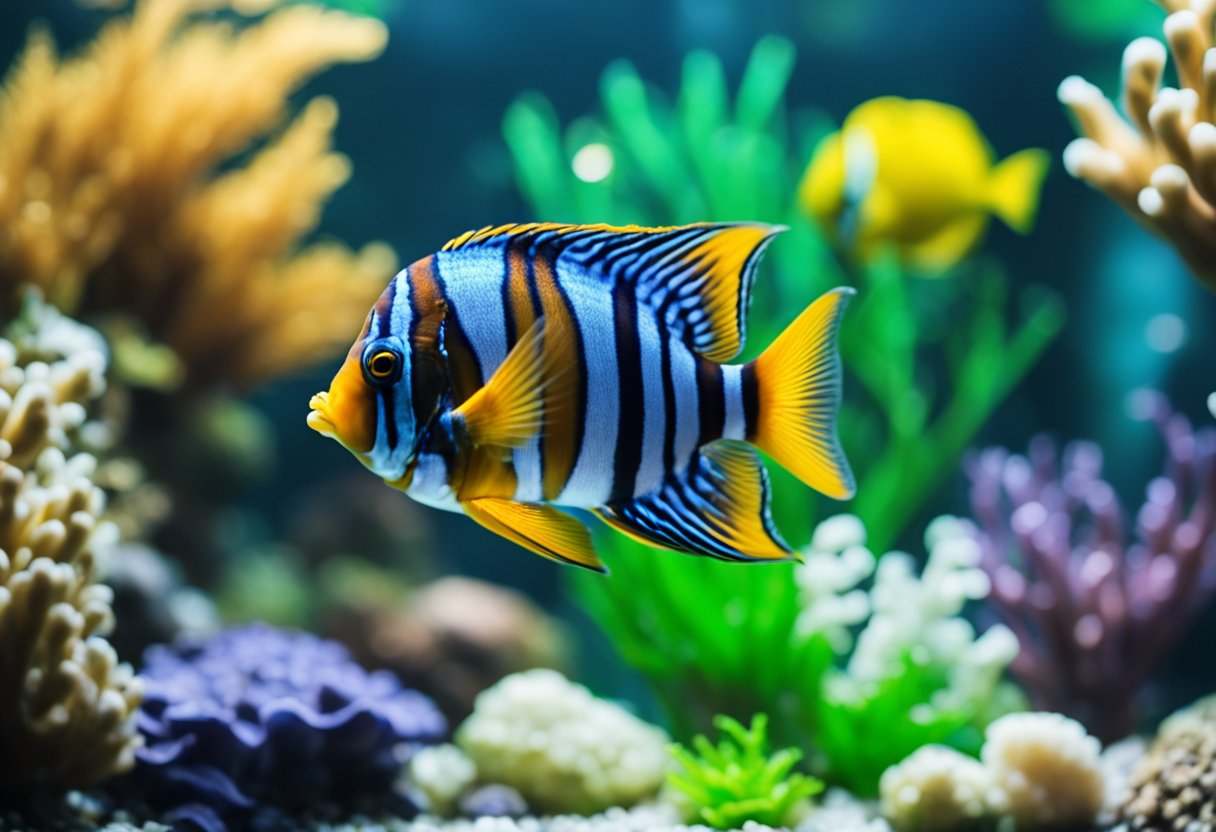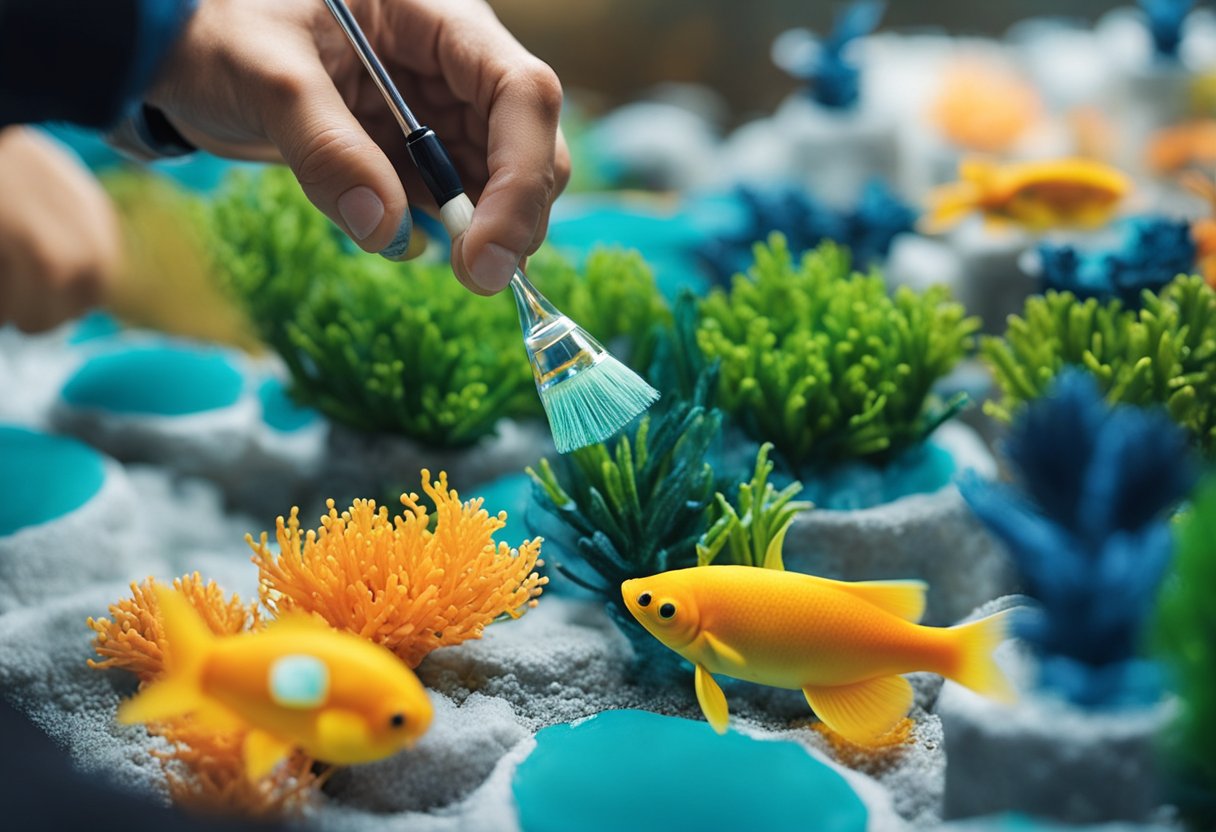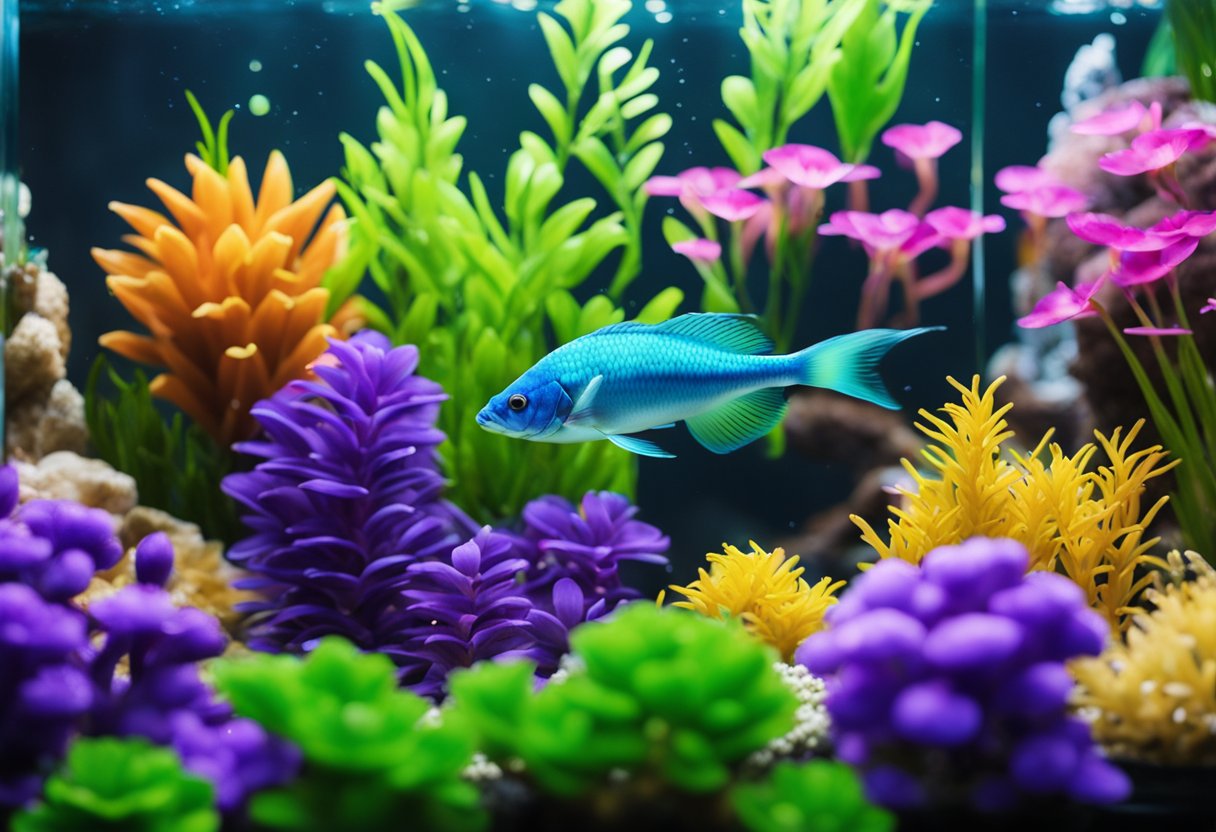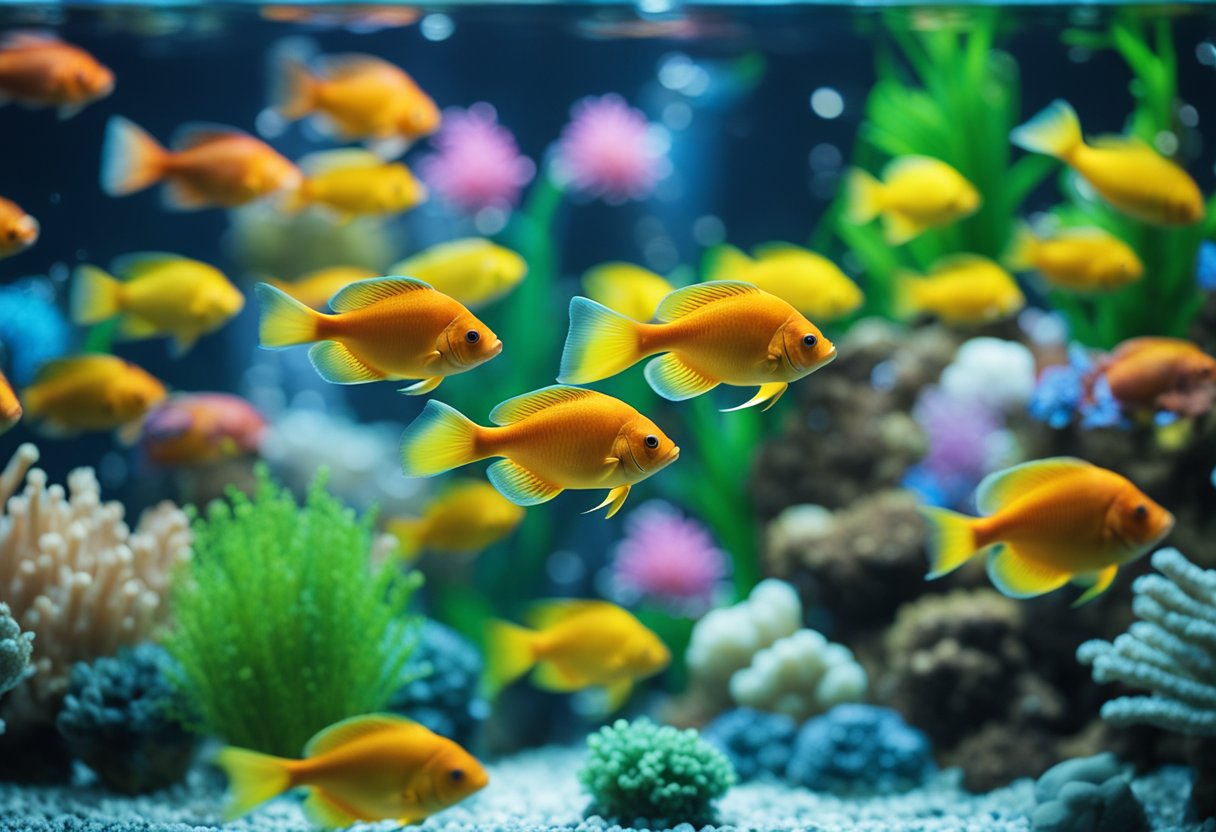I have researched the topic of whether acrylic paint is safe for fish and aquariums. Acrylic paint is a popular choice for decorating aquariums due to its versatility and ability to create a unique look. However, it is important to consider the safety of the paint for the fish and other aquatic life in the tank.
Understanding acrylic paint is the first step in determining its safety for aquariums. Acrylic paint is made of pigments suspended in an acrylic polymer solution and acrylic resin. It is a water-based paint that dries quickly and is waterproof when cured. While it is generally non-toxic, some acrylic paints may contain harmful chemicals that could be dangerous for fish and other aquatic life. It is important to choose a paint that is specifically labeled as safe for aquariums and fish.
Understanding Acrylic Paint
https://www.youtube.com/watch?v=PX7DR0rRLYo&embed=true
Acrylic paint is a water-based paint that is made up of pigment particles suspended in an acrylic polymer emulsion. It is a popular type of paint that is widely used in various applications, including painting on canvas, wood, metal, and even plastic.
One of the advantages of acrylic paint is that it is fast-drying and water-resistant. This makes it an ideal choice for painting aquarium decorations such as rocks, statues, and even the tank itself.
Acrylic paint is also known for its low VOC (volatile organic compound) content, which means that it is less harmful to the environment and human health compared to other types of paint. This is because it contains fewer solvents that can evaporate into the air and cause air pollution.
However, it is important to note that not all acrylic paints are created equal. Some formulations may contain additives or pigments that are not safe for aquatic environments. It is crucial to choose a high-quality, non-toxic acrylic paint that is specifically designed for aquarium use.
To ensure that the paint is safe for fish and other aquatic organisms, it is also important to properly seal the painted surface. This can be done by applying a non-toxic sealant over the painted surface to prevent any harmful substances from leaching into the water.
In summary, acrylic paint is generally safe for aquarium use as long as it is non-toxic, properly sealed, and specifically designed for aquatic environments. When choosing an acrylic paint for your aquarium, make sure to check the label for any harmful additives or pigments, and always follow the manufacturer’s instructions for proper application and sealing.
Acrylic Paint and Aquariums
https://www.youtube.com/watch?v=SwUPSvDAOVI&embed=true
As an aquarium enthusiast, I understand the importance of maintaining a healthy and safe environment for my fish. One question that often arises is whether acrylic paint is safe to use in aquariums.
Acrylic paint is generally considered safe for aquariums when used correctly. However, it is important to note that not all acrylic paints are suitable for aquatic environments. Some acrylic paints may contain toxic substances or additives that can be harmful to fish and other aquatic organisms. Therefore, it is essential to choose the right type of acrylic paint that is safe for aquariums.
When choosing acrylic paint for an aquarium, it is crucial to look for paints that are labeled as “aquarium safe” or “fish-safe.” These types of paints are specifically formulated to be non-toxic and safe for use in aquatic environments. Some of the best aquarium safe paints include epoxy, polyurethane, and silicone-based paints.
It is important to note that not all surfaces in an aquarium can be painted. For example, the rear glass panel of an aquarium should not be painted as it can affect the lighting and visibility of the aquarium. However, aquarium backgrounds and 3D aquarium backgrounds can be painted with aquarium safe paints to create a more natural and appealing look for your aquarium.
In conclusion, using acrylic paint in an aquarium can be safe as long as the right type of paint is used and the surfaces to be painted are appropriate. When in doubt, it is always best to consult with an aquarium expert or professional before painting any surfaces in your aquarium.
Safety of Acrylic Paint for Fish
https://www.youtube.com/watch?v=Z2xcBcGlSzU&embed=true
As an artist and aquarium enthusiast, I have often wondered if acrylic paint is safe for fish and aquatic life. After conducting research and consulting with experts, I can say with confidence that acrylic paint is generally safe for fish when used properly.
Acrylic paint is non-toxic and water-based, which makes it safe for fish and aquatic life. Unlike oil-based paints, acrylic paints do not contain solvents that can be harmful to fish. However, it is important to note that not all acrylic paints are created equal. Some acrylic paints may contain additives or pigments that are not safe for fish. Therefore, it is important to use only aquarium-safe acrylic paints that are specifically formulated for use in aquatic environments.
When selecting an aquarium-safe acrylic paint, it is important to check the label and ensure that it is safe for fish. Some of the best aquarium-safe acrylic paints include Liquitex, Golden, and Winsor & Newton. These brands are known for their high-quality, non-toxic paints that are safe for fish and aquatic life.
It is also important to note that acrylic paint can become toxic to fish if it is not allowed to fully cure before being placed in the aquarium. Therefore, it is recommended to wait at least 72 hours after painting before placing any painted objects or decorations in the aquarium. This allows the paint to fully cure and ensures that any potentially harmful chemicals have dissipated.
In conclusion, acrylic paint is generally safe for fish and aquatic life when used properly and when aquarium-safe paints are selected. However, it is important to always check the label and allow the paint to fully cure before placing any painted objects in the aquarium.
Chemicals in Acrylic Paint
https://www.youtube.com/watch?v=bKtfmcX7CiI&embed=true
As an artist, I have been using acrylic paint for years. I have always been curious about the chemicals used in acrylic paints and if they are safe for fish in aquariums. Acrylic paint is made of pigments suspended in an acrylic polymer emulsion. It is water-soluble and dries quickly, making it a popular choice for artists.
However, not all acrylic paints are created equal. Some contain harmful chemicals that can be toxic to fish. It is important to read the label before using any paint in an aquarium. The label should indicate if the paint is safe for use in an aquarium or not.
One of the harmful chemicals that can be found in some acrylic paints is lead. Lead is a toxic metal that can cause serious health problems in fish and other aquatic animals. It is important to avoid any paint that contains lead or any other harmful chemicals.
Another harmful chemical that can be found in some acrylic paints is formaldehyde. Formaldehyde is a colorless gas that can cause irritation to the eyes, nose, and throat. It can also cause respiratory problems in fish and other aquatic animals.
Toxicity is a major concern when it comes to using any paint in an aquarium. Even if the paint is labeled as safe, it is important to monitor the fish and other aquatic animals for any signs of distress. If you notice any changes in behavior or health, it is important to remove the paint immediately.
In conclusion, it is important to be aware of the chemicals used in acrylic paint and their potential harm to fish and other aquatic animals. Always read the label and avoid any paint that contains harmful chemicals. It is better to be safe than sorry when it comes to the health of your aquarium inhabitants.
Alternatives to Acrylic Paint
As we have seen, acrylic paint is generally considered safe for fish when used properly. However, if you are still concerned about using acrylic paint in your aquarium, there are a few alternatives you can consider.
Epoxy Paint
Epoxy paint is a popular alternative to acrylic paint for aquariums. It is a two-part paint that consists of a resin and a hardener. When mixed together, they create a strong, durable coating that is resistant to water and chemicals. Epoxy paint is also non-toxic and safe for fish.
Latex Paint
Latex paint is another option for aquariums. It is a water-based paint that is easy to apply and dries quickly. Latex paint is also non-toxic and safe for fish. However, it may not be as durable as other types of paint and may need to be reapplied more frequently.
Krylon Fusion All-In-One Spray Paint
Krylon Fusion All-In-One Spray Paint is a popular choice for aquariums. It is a spray paint that is designed to bond to plastic, metal, wood, and other surfaces. It is also safe for fish and other aquatic life. Krylon Fusion All-In-One Spray Paint is available in a variety of colors and finishes, making it easy to customize your aquarium.
Plasti Dip
Plasti Dip is a rubber coating that can be used to seal and protect surfaces in aquariums. It is non-toxic and safe for fish. Plasti Dip is available in a variety of colors and can be applied using a spray can or brush.
Rust-Oleum
Rust-Oleum is a brand that offers a variety of paints and coatings that are safe for aquariums. Their products include epoxy paint, spray paint, and brush-on paint. Rust-Oleum paints are non-toxic and safe for fish.
Overall, there are several alternatives to acrylic paint that are safe for fish and can be used in aquariums. When choosing a paint, it is important to consider the durability, toxicity, and ease of application.
Application and Curing of Paint
https://www.youtube.com/watch?v=SIZXNeY29OI&embed=true
When it comes to painting an aquarium, it is important to ensure that the paint is safe for the fish and other aquatic life. Acrylic paint is a popular choice for aquariums because it is water-based and less toxic than other types of paint. However, it is important to follow proper application and curing procedures to ensure that the paint is safe for the fish.
First, it is important to prepare the work area before painting. This includes covering the surrounding area with newspaper or a drop cloth to prevent paint from getting on other surfaces. Additionally, masking tape can be used to protect areas that should not be painted, such as the edges of the aquarium. It is also important to ensure that the work area is well-ventilated to prevent inhalation of fumes.
Before applying the paint, it is recommended to clean the surface of the aquarium with a mild soap and water. This will remove any dirt or debris that could affect the adhesion of the paint. Once the surface is clean and dry, the paint can be applied using a paint roller or brush.
It is important to follow the manufacturer’s instructions when applying the paint, including the recommended thickness and number of coats. After the paint is applied, it must be allowed to cure fully before adding water or fish to the aquarium. The curing time can vary depending on the type of paint and the thickness of the coat, so it is important to follow the manufacturer’s instructions.
During the curing process, it is important to ensure that the area remains well-ventilated to prevent inhalation of fumes. Once the paint is fully cured, it should be safe for the fish and other aquatic life in the aquarium.
In summary, when using acrylic paint for an aquarium, it is important to properly prepare the work area, follow the manufacturer’s instructions for application and curing, and ensure that the area remains well-ventilated during the process. By following these steps, you can ensure that the paint is safe for the fish and other aquatic life in your aquarium.
Ensuring Safety of Aquarium Decorations
As an aquarium enthusiast, I know how important it is to ensure the safety of my fish. One of the most common questions I get asked is whether acrylic paint is safe for aquarium decorations. While acrylic paint is generally safe for use in aquariums, it is important to take certain precautions to ensure the safety of your fish.
When using any type of decoration in your aquarium, it is important to make sure that it is non-toxic and safe for your fish. This includes rocks, plants, PVC pipes, concrete, and any other type of decoration you may want to use. Always check the label of any decoration you plan to use to ensure that it is safe for aquarium use.
In addition to checking the label of your decorations, it is also important to use a sealant or silicone to waterproof and seal any porous decorations. This will help prevent any harmful chemicals or bacteria from leaching into the water and harming your fish. Look for sealants or silicone that are mold-resistant and waterproofer, to ensure that they will hold up well in the aquarium environment.
When painting aquarium decorations, it is important to use only aquarium-safe paints. These paints are specifically formulated to be non-toxic and safe for use in aquariums. Some of the best aquarium-safe paints include Krylon Fusion, Rust-Oleum Painter’s Touch, and Plasti Dip.
In conclusion, ensuring the safety of your aquarium decorations is essential to the health and well-being of your fish. Always check the label of any decoration you plan to use, use a sealant or silicone to waterproof and seal any porous decorations, and use only aquarium-safe paints when painting decorations. By taking these precautions, you can create a beautiful and safe environment for your fish to thrive in.
Final Thoughts on Acrylic Paint for Aquariums
In conclusion, acrylic paint is safe for aquariums when used correctly. It is a durable and waterproof option that can be used to customize aquariums with a matte finish. However, it is important to use an aquarium-safe paint that is labeled as safe for animals and potable containers.
When using acrylic paint in an aquarium, it is important to follow the manufacturer’s instructions carefully. Allow each coat to dry completely before applying additional coats. It is also important to note that acrylic paint can be removed with isopropyl alcohol or acetone, so care should be taken to avoid these substances near the painted areas.
A rubber coating can also be used over the acrylic paint to provide an extra layer of protection and durability. It is important to choose a rubber coating that is safe for use in potable containers and labeled as aquarium-safe.
Overall, acrylic paint is a great option for customizing aquariums, but it is important to choose a paint that is safe for use in an aquatic environment. By following the manufacturer’s instructions and taking proper precautions, acrylic paint can be a safe and effective way to add personality and flair to your aquarium.
Frequently Asked Questions
Is acrylic paint safe for use in fish tanks?
Acrylic paint can be safe for use in fish tanks as long as it is labeled as aquarium-safe. However, not all acrylic paints are suitable for aquatic environments. Some acrylic paints may contain toxic substances or additives that can be harmful to fish and other aquatic organisms. It is important to choose the right type of paint for your aquarium.
What types of paint are safe for aquarium use?
Water-based acrylic paints that are labeled as aquarium-safe are generally safe for use in fish tanks. It is important to avoid using oil-based paints or any other type of paint that contains solvents or other chemicals that can leach into the water and harm your fish.
Can painted rocks be used in a fish tank?
Painted rocks can be used in a fish tank as long as the paint used is aquarium-safe. It is important to avoid using any type of paint that can leach into the water and harm your fish.
Are there any risks associated with using acrylic paint in a fish tank?
There are some risks associated with using acrylic paint in a fish tank. If the paint is not aquarium-safe, it can leach harmful chemicals into the water and harm your fish. Additionally, if the paint is not applied correctly, it can chip or peel off and create a hazard for your fish.
What are the best brands of aquarium-safe paint?
There are several brands of aquarium-safe paint available on the market. Some of the most popular brands include Krylon Fusion, Rust-Oleum Painter’s Touch, and Pond Armor. It is important to choose a paint that is specifically labeled as aquarium-safe to ensure the safety of your fish.
How long should I wait before adding fish to a tank painted with acrylic paint?
It is important to wait at least 24-48 hours before adding fish to a tank painted with acrylic paint. This will allow the paint to fully dry and cure, reducing the risk of any harmful chemicals leaching into the water.

Hi, I’m Sal Muller of Tooltrip.com. My DIY experience led me to understand essential power tools for home projects. Tooltrip.com guides enthusiasts and professionals in choosing right tools for any job. I provide concise top tool reviews for easier, efficient DIY.






